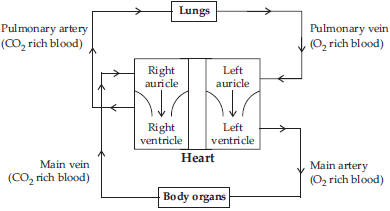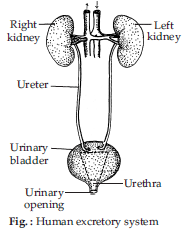Transportation in Animals and Plants (Biology) Class 7 - NCERT Questions
Match structures given in Column I with functions given in Column II.

(i) - (B), (ii) - (D), (iii) - (A), (iv) - (C)
Q 2.Fill in the blanks.
(i) The blood from the heart is transported to all parts of the body by the __________ .
(ii) Haemoglobin is present in ___________ cells.
(iii) Arteries and veins are joined by a network of ___________ .
(iv) The rhythmic expansion and contraction of the heart is called ___________ .
(v) The main excretory product in human beings is ___________ .
(vi) Sweat contains water and ___________ .
(vii) Kidneys eliminate the waste materials in the liquid form called ___________ .
(viii) Water reaches great heights in the trees because of suction pull caused by ______ .
(i) arteries (ii) red blood (iii) capillaries (iv) heart beat (v) urea (vi) salts (vii) urine (viii) transpiration
Q 3.Choose the correct option:
(A) In plants, water is transported through
(i) xylem (ii) phloem (iii) stomata (iv) root hair
(B) Water absorption through roots can be increased by keeping the plants
(i) in the shade (ii) in dim light
(iii) under the fan (iv) covered with a polythene bag


Why is transport of materials necessary in a plant or in an animal? Explain.
SOLUTION:Transport of materials is necessary in plants and animals because
(i) Every cell needs a regular supply of nutrients and oxygen to release energy through respiration. These nutrients and oxygen need to be transported to all the cells of the body, through a transport system, so that they can produce energy.
(ii) Waste products generated by cells need to be transported to the excretory organs, because accumulation of these waste products causes harmful effects on the organism’s body.
What will happen if there are no platelets in the blood?
SOLUTION:Platelets are responsible for clothing of blood. If there are no platelets, then blood would not clot in case of an injury. This will lead to excessive blood loss, and finally death of the person.
Q 6.What are stomata? Give two functions of stomata.
SOLUTION:Stomata are tiny pores that are mainly present on the surface of leaves. The functions of stomata are:
(i) During photosynthesis and respiration, stomata help in exchange of gases (carbon dioxide and oxygen).
(ii) Stomata help in evaporation of water from the leaf surface during the process of transpiration.
Does transpiration serve any useful function in the plants? Explain.
SOLUTION:Transpiration is an essential process for the plants because :
(i) It creates a suction pull (transpiration pull) due to which water and minerals rise high up in the tall trees. Thus, it helps in ascent of sap.
(ii) Transpiration helps to cool the plant, due to evaporation of water.
What are the components of blood?
SOLUTION:The main components of blood are — plasma and blood cells (or blood corpuscles).
Plasma is the fluid part of blood in which the blood cells are suspended. The plasma contains water, minerals, nutrients, proteins etc.
Blood cells are of three types — RBCs (Red blood cells), WBCs (White blood cells) and blood platelets.
Why is blood needed by all the parts of a body?
SOLUTION:Blood is an important part of our transport system. It is needed by all parts of our body because it performs following important functions :
(i) It transports digested food from small intestine to all parts of the human body.
(ii) It carries oxygen from lungs to the heart, and then to the body cells.
(iii) It carries carbon dioxide (a waste product) from the body cells to the lungs via heart.
(iv) It carries nitrogenous wastes from the body cells to the kidneys for excretion.
(v) Blood helps to fight against disease causing germs and infections.
(vi) Blood helps to regulate the body temperature.
What makes the blood look red?
SOLUTION:Presence of haemoglobin, a red-coloured pigment, in the RBCs of blood, makes blood appear red in colour.
Q 11.Describe the function of the heart.
SOLUTION:The heart has four chambers—two upper chambers are called auricles and two lower chambers are called ventricles. The left chambers of the heart are completely separated from right chambers of the heart, to prevent the mixing of oxygen-rich and carbon dioxide-rich blood.
The vena cava (main veins) bring deoxygenated blood from all parts of the body to the right atrium. The right atrium pumps this blood into the right ventricle, which then pumps it into the pulmonary artery. This artery takes the blood to the lungs for oxygenation.
The oxygenated blood is received by the left atrium through the pulmonary veins (2 each from the right and left lungs). It is then pumped into the left ventricle, which in turn, pumps the blood into the aorta (main artery), through which it is supplied to all parts of the body.
The circulation of blood can be illustrated by the following flow chart : 
Why is it necessary to excrete waste products?
SOLUTION:Waste products produced by our body such as urea, carbon dioxide, salts etc. are toxic in nature. If accumulated, they can damage our body parts, and hence prove fatal. Therefore, waste products are necessary to be excreted out.
Q 13.Draw a diagram of the human excretory system and label the various parts.
SOLUTION:The labelled diagram of the human excretory system is as follows : 